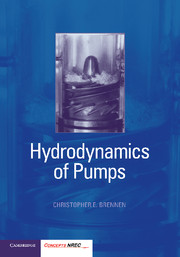Book contents
- Frontmatter
- Contents
- Preface
- Nomenclature
- 1 Introduction
- 2 Basic Principles
- 3 Two-Dimensional Performance Analysis
- 4 Other Flow Features
- 5 Cavitation Parameters and Inception
- 6 Bubble Dynamics, Damage and Noise
- 7 Cavitation and Pump Performance
- 8 Pump Vibration
- 9 Unsteady Flow in Hydraulic Systems
- 10 Radial and Rotordynamic Forces
- Bibliography
- Index
9 - Unsteady Flow in Hydraulic Systems
Published online by Cambridge University Press: 04 February 2011
- Frontmatter
- Contents
- Preface
- Nomenclature
- 1 Introduction
- 2 Basic Principles
- 3 Two-Dimensional Performance Analysis
- 4 Other Flow Features
- 5 Cavitation Parameters and Inception
- 6 Bubble Dynamics, Damage and Noise
- 7 Cavitation and Pump Performance
- 8 Pump Vibration
- 9 Unsteady Flow in Hydraulic Systems
- 10 Radial and Rotordynamic Forces
- Bibliography
- Index
Summary
Introduction
This chapter is devoted to a description of the methods available for the analysis of unsteady flows in pumps and their associated hydraulic systems. There are two basic approaches to the solution of unsteady internal flows: solution in the time domain or in the frequency domain. The traditional time domain methods for hydraulic systems are treated in depth elsewhere (for example, Streeter and Wylie 1967, 1974), and will only be touched upon here. They have the great advantage that they can incorporate the nonlinear convective inertial terms in the equations of fluid flow, and are best suited to evaluating the transient response of flows in long pipes in which the equations of the flow and the structure are fairly well established. However, they encounter great difficulties when either the geometry is complex (for example inside a pump), or the fluid is complex (for example in the presence of cavitation). Under these circumstances, frequency domain methods have distinct advantages, both analytically and experimentally. On the other hand, the nonlinear convective inertial terms cannot readily be included in the frequency-domain methodology and, consequently, these methods are only accurate for small perturbations from the mean flow. This does permit evaluation of stability limits, but not the evaluation of the amplitude of large unstable motions.
It should be stressed that many unsteady hydraulic system problems can and should be treated by the traditional time domain or “water-hammer” methods.
- Type
- Chapter
- Information
- Hydrodynamics of Pumps , pp. 172 - 208Publisher: Cambridge University PressPrint publication year: 2011
- 2
- Cited by



